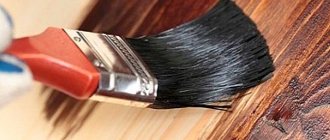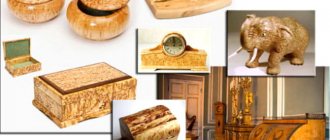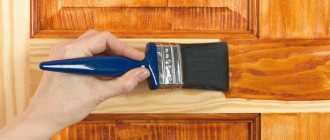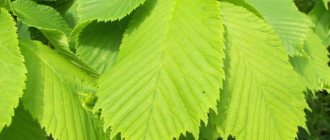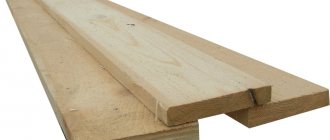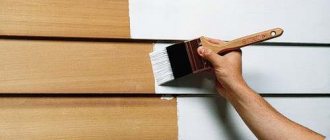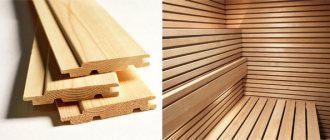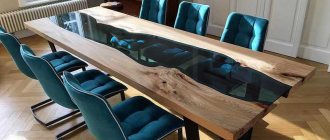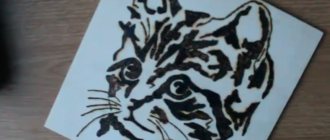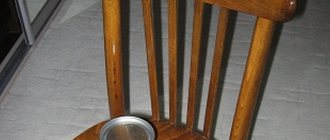Wood, under the influence of negative factors, over time loses its natural attractiveness and deteriorates its performance characteristics: it fades under the influence of UV; deformed from excess moisture; rot when pathogenic microflora multiply.
To give a rich shade, preserve the structure, protect against destruction and extend service life , a special wood stain is used. Read more about what types of compositions there are, how to prepare them and what are the features of processing wooden surfaces.
Stain is a paint or impregnation
The liquid substance with which a wooden product is impregnated and changes its shade is usually called stain.
- Interesting! This substance began to be called stain only recently; previously there was another name such as “beytsy”.
- Which is translated from German as dye. The solution could also be called “Cologne soil.”
- Because the first such substance was derived from humus, which was mined in the suburbs of Cologne.
- The brown color was the result of soaking the rotted substance in water. This stain has survived to the present day.
This composition, unlike paint, impregnates the upper layers of wood. If paints and varnishes give color to wooden products, hiding its entire structure.
Then, during impregnation with stain, peculiar transformations occur with the wood, which lead to a change in its shade, but the entire structure of the wooden product is not only preserved. But it also becomes very pronounced, i.e. The natural patterns of the wood are not changed.
For example, to convert alder into oak, a stain is applied to the product, which changes the shade of the wood. The market offers many varieties of this impregnation in natural color and with the addition of various dyes.
Creating effects
Alcohol or water stain can create an imitation of the naturalness of the coating without obvious traces of processing. When choosing a material for protection and painting, focus on the desired effect: choose a shade of oak, pine or ebony (as in the photo) - the interior will instantly be ennobled.
Products made from ash or oak do not need to be tinted - leave their structure and shade open, choosing the shade of this species that is as close to nature as possible.
Properly stained wood should retain its natural appearance. Only acrylic or wax stains stand out, the color range of which goes beyond naturalness.
The properties of each type of wood are different. In order not to make a mistake when purchasing, pay attention to the flower palette: the composition is applied to planks of different types, where you can see the final result.
Application of stain
Another main feature of this liquid solution is that it protects the tree from external influences. For this, various types of finishing coatings are used. But the main uses of stains are as follows:
- Changing the tone of wood products;
- For restoration of objects;
- <<For counterfeiting products>> for more expensive wood options;
- To provide wood with antiseptic protection;
- To highlight the natural pattern;
- For protection against external and internal damage (for outdoors and indoors).
Technique for highlighting wood patterns
The use of stain for tinting wood is often directly related to emphasizing its natural pattern. For this, a special technique is used, called brushing (from the English word “brush” - “brush”). By using this technology, you can not only highlight the design with color, but also give it a beautiful relief.
The technology is possible to implement due to the existing difference in the hardness of the wood layers. If you look at a cross section of a tree, you can see a pattern formed by annual rings, consisting of fibers with different strength characteristics. Their main difference is their different densities - among the hard layers there are softer ones that are easy to process.
An example of a wooden part that has been processed using the brushing method.
The natural relief appears when the top layer of soft wood fibers is removed, due to which it becomes decorative. The stain used in this method of transforming the material contributes to the color highlighting of the structural pattern.
To use this technique in combination with tinting, any type of wood with thick or thin longitudinal fibers is suitable. Wood structured in this way is used for the manufacture of furniture, flooring, paneling, as well as for the manufacture of individual elements of decorative finishing, for example, framing cladding made of other materials.
Brushing can be called the simplest and most affordable method of giving wood individuality and decorativeness, as well as, if necessary, artificially “aging” the material. In this case, the depth of the relief can be distinguished in different ways. For example, boards intended for flooring are not deeply processed, since dust and dirt will collect in the recesses. However, the pattern can be distinguished visually by using one or more stain solutions.
Brushed and stained boards.
It is quite possible to carry out the process of such wood decoration at home. This will require some simple hand tools and some common power tools.
Tools and devices that can be used to create structural relief on the surface of wood.
So, to give the tree a certain look, you need to prepare the following tools and materials:
- Wood stains for tinting, as well as brushes, rollers or spray guns. The tool is selected depending on the consistency of the tinting composition.
- Hand-held metal brushes of varying hardness, or a grinder (electric drill, screwdriver) with a metal brush attachment. These instruments are used to remove softer fibers.
- Sandpaper of different grain sizes - for rough cleaning and fine polishing of the relief.
- Varnish for the final coating of the finished product.
Sanding the board with a sander and a wire brush.
Everything is fine, but the master works with his bare hands. Don’t follow his example - don’t neglect your protective equipment! It should be noted that with a small sander at your disposal, the work can be done much faster, and the cleaning of the wood will be more uniform. This is due to the fact that the device operates at a constant speed.
For grinders, special narrow or wide brush attachments are provided, made of metal, polymers with an abrasive applied to it, as well as hair or sisal. By adhering to the step-by-step work, using such a power tool, you can make ideally decorated parts or blanks from wood for installing interior cladding.
The work is carried out in the following order:
Samples of blanks coated with a double layer of stain and brushed.
- If you plan to show the structural design in color, then the first step is to whiten the board or other wooden piece using one of the types of stain. After this, you should wait until the material dries completely - it should form a dense layer or completely saturate the wood several millimeters deep.
- A colored layer of stain is applied on top of the bleached workpiece so that it completely covers the primary one. The second layer of solution must also dry well, otherwise the wood will produce burrs during processing.
Kinds
The market offers four varieties of beys. These are water-based, alcohol-based, wax and impregnations made using natural or artificial oils. Also, construction departments of stores offer paints with acrylic or gel.
Most stains are produced in the form of a liquid substance, but you can also find a dry version. How all these substances are used and which stain is better can be found in the article below.
Water impregnation
Water-based stain is the most popular product on hardware store shelves. It is produced in three versions: concentrate, powder and ready-made solution. In this case, after dilution, the powder stain must be cleaned of excess impurities by straining the solution through cheesecloth.
If this is not done, you should not expect the desired effect from the stain. Another feature of the aqueous solution is the change in its shade depending on the decrease or increase in the concentration of the solution.
- Buyers loved this stain for its low cost, economical consumption and due to the absence of a strong odor, as is the case with standard paint.
- Therefore, the solution is ideal for internal application, both on the walls and floor of the room, and on interior items.
Moreover, the color of the paint can be changed very easily by applying one layer of impregnation to lightly tint the wood or a couple of layers to give the product a more saturated shade.
Alcohol based impregnation
Alcohol stain is produced in two types: liquid substance and powder concentrate. To completely convert them into the required composition, alcohol is used. But there is one big disadvantage here - the pungent smell of stain and the need for some experience to work with it.
Therefore, its use is postponed until the warm season, to ensure good ventilation of the rooms where the products will be painted. The solution is also used for external work.
Buyers value alcohol stain for the following qualities: quick drying, excellent penetration into wood, and a large assortment.
Advice! A spray gun is best suited for painting products with this stain. Unlike traditional brushes and rollers, it will ensure the necessary penetration of the solution into the wood.
Wax solution
The most modern stain that provides wood with a thin film-like layer. Due to the fact that the substance does not completely penetrate the wood, it is used as a base for paint.
- Stain is quite expensive, so it is used for finishing work.
- It protects wood from the influence of climatic seasons, removing even minor defects on the product and is excellent for both outdoor work and indoor use.
- After all, it is characterized by the absence of an unpleasant odor of chemical impurities.
Oil solution
This stain is represented by oil stain. The solution also contains color and drying oil. Thanks to these two components, the color of the impregnation can be obtained in any color, from the most natural light to the dark shade of expensive wood.
- According to customer reviews, stain perfectly saturates wood, penetrating it without unnecessary drips.
- It is also the best protection against water and harmful insects.
- Impregnation is used mainly for external work, but can also be used for painting floor surfaces or interior items.
Important! Before using the oil solution, it is worth considering that it takes a long time to dry. Therefore, things painted with stain cannot be used for a long time. This is especially important if the solution covers the threshold on the veranda or the entrance door to the room.
Acrylic stain
This solution is famous for its quick drying (1 hour). It is made using acrylic resins and has a thick composition. Beys come in a variety of colors, so choosing the right shade won’t be difficult.
Buyers note the following positive qualities of the emulsion: protection from insects and weather conditions, environmentally friendly composition, odorless and does not burn, excellent combination with any type of wood. This all justifies the high price of the stain.
Application rules
The wax emulsion is applied with a brush.
In conclusion, we would like to give some practical tips on applying stain to a surface. In each specific case, the instructions will have their own characteristics, but we will try to consider the most general points.
So, let's start by reminding you: stain is not paint, it must be absorbed into the pores to a certain depth, so the most favorable conditions for this should be created.
Basic application methods.
First of all, you should prepare the surface. It must be cleaned of any coatings, dirt and dust, and also treated with fine abrasive sandpaper to open the pores. It must be remembered that they will be open for no longer than two hours, so grinding must be done immediately before starting work.
You should also prepare the stain. It can be heated to a temperature of 40 - 50 ˚С, so it will be more fluid and better absorbed into the material. It is especially important to ensure the permeability of dense wood species; for this, the composition can be diluted with water, and if the wood stain is non-aqueous, with a solvent.
Applying the solution with a brush.
When working with aqueous solutions, in order to avoid raising the fibers, which is fraught with loss of protection from moisture, the surface is pre-wetted, and then wait a while and sand it with sandpaper. This allows you to neutralize the unwanted effect.
When applying the material with a brush, work along the grain lines. Thick formulations and gels should be rubbed in thoroughly; for this you can use cotton swabs wrapped in cotton cloth or gauze.
Oil and nitro stains are quite toxic, so when working with them it is better to ventilate the room or go outside. Gloves and eye glasses are also a good idea.
To create the effect of aged wood, the stain is first applied liberally and then wiped off with a cloth. This way the texture becomes especially expressive and varied. For this work, you should use oil or wax.
Alcohol compounds are poisonous.
Important! Alcohol solutions are made on the basis of ethyl denatured alcohol, which can contain up to 10% methanol, which is a dangerous poison.
How to use
Important! Before applying impregnation, you must carefully familiarize yourself not only with the wood, but also with the composition of the stain that will be used during the work.
Impregnation is applied in the following ways:
- By rubbing the stain. For work, soft cloth or foam rubber is used. This gives the effect of a pronounced wood color, which is achieved by staining for loose wood or an overdried product;
- By spraying the solution. During the work, a spray gun is used, which gives the wood a rich shade. Therefore, the color of the stain is selected a little lighter than the required option;
- By pouring. The solution is applied with a brush to a wooden canvas or product. And wait about 20 minutes until the stain is absorbed. Then remove the unabsorbed layer with a clean cloth. One thing is important here: the longer the solution stays on the object, the brighter its shade will be;
- Using a brush. Traditional brushes of the required sizes are used. The color of the product depends on the number of layers applied to the surface of the object.
How long does it take to dry?
Each type of stain has different drying times , which are indicated on the packaging or in the instructions for the selected composition.
- When applied to a surface, water stains dry from 12 to 20 hours;
- alcohol compositions dry quickly, up to 5-7 minutes. In low temperature or high humidity conditions, drying time may be 30 minutes;
- oil impregnations dry in 1 to 2 days after application;
- acrylic compositions dry within 60 minutes;
- Wax stains dry for 12-14 hours after application.
Photos of all types of wood stains
Antiseptics
Antiseptics, like impregnations, are used to protect building materials from damage and destruction. They contain biocides and poisons that help destroy certain microorganisms and prevent their reappearance. The scope of application of construction antiseptics is extensive. They are used for treating lime and lime-cement surfaces, brick, concrete, joints between tiles, facades, plasters, walls, ceilings, and wooden structures. High-quality antiseptics have the following properties:
- they are safe for human and animal health, but are highly toxic to fungi, mold and insects;
- do not change the physical and mechanical properties of materials with which they come into contact;
- have the ability to penetrate deeply into concrete and wood;
- do not change their properties during storage and use.
Staining
Products are painted with stain in the following order:
- the impregnation should be slightly heated to enhance penetrating power;
- soak the tool in the staining compound and remove excess to prevent drips. When using a spray gun, fill the tank;
- wood should be processed along the grain. A steady, continuous movement of the brush will help prevent stains;
- Use a clean rag to collect excess impregnation;
- wait for it to dry completely;
- Apply another 2-3 layers to achieve the required color saturation.
Stain will help improve the appearance and quality of wood products. It will protect the base from rapid destruction. It is important to choose the right impregnation and carefully study the instructions for use and characteristics of the product. It is also important when choosing to consider what exactly the stain is needed for - to protect or improve the appearance.
Preparation
In cases where the wood being prepared for staining is from coniferous trees, then before painting it should be deresined, that is, the surface should be freed of resin. Also, the preparation process necessarily includes thorough sanding. Even a surface that is smooth at first glance must be sanded, since after staining all the slightest irregularities and defects will appear on the wood, which will significantly spoil the aesthetic appearance of the product. The cleaned wood should be degreased - treated with a sponge previously soaked in solvent.
